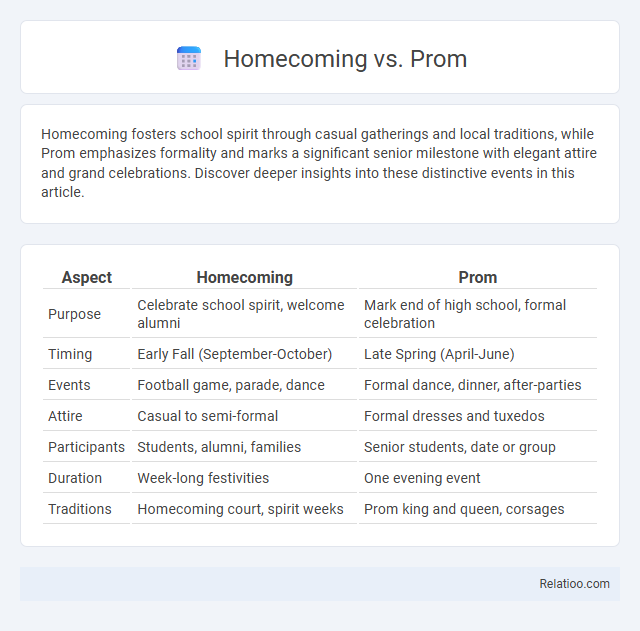Homecoming fosters school spirit through casual gatherings and local traditions, while Prom emphasizes formality and marks a significant senior milestone with elegant attire and grand celebrations. Discover deeper insights into these distinctive events in this article.
Table of Comparison
| Aspect | Homecoming | Prom |
|---|---|---|
| Purpose | Celebrate school spirit, welcome alumni | Mark end of high school, formal celebration |
| Timing | Early Fall (September-October) | Late Spring (April-June) |
| Events | Football game, parade, dance | Formal dance, dinner, after-parties |
| Attire | Casual to semi-formal | Formal dresses and tuxedos |
| Participants | Students, alumni, families | Senior students, date or group |
| Duration | Week-long festivities | One evening event |
| Traditions | Homecoming court, spirit weeks | Prom king and queen, corsages |
Understanding Homecoming and Prom: Key Differences
Homecoming and prom are two distinct high school events with different purposes and traditions. Homecoming centers around welcoming back alumni with activities like a football game and a parade, while prom is a formal dance celebrating the end of the school year, primarily for seniors. Understanding these key differences helps students and parents navigate expectations, attire, and event significance.
Origins and Traditions of Homecoming
Homecoming originated in the early 20th century as a way for universities, especially in the United States, to welcome back alumni, often revolving around a football game and festive events like parades and pep rallies. Traditions of Homecoming include crowning a Homecoming King and Queen, school spirit activities, and community celebrations aimed at fostering a sense of belonging. Unlike Prom, which is a formal dance primarily for current students, Homecoming emphasizes alumni engagement and school pride through various social and athletic gatherings.
The History and Evolution of Prom
Prom originated in the late 19th century as formal debutante balls marking a young person's transition into adulthood, evolving significantly through the 20th century to become a widely celebrated high school tradition in the United States. The historical roots of Prom differentiate it from Homecoming, which began as a college football rally in the early 1900s, later adopted by high schools to celebrate school spirit and alumni reunions. Your understanding of these events deepens by recognizing Prom's evolution from exclusive formal dances into inclusive celebrations symbolizing youthful milestones, contrasting with Homecoming's focus on community and school pride.
Typical Dates and Seasons for Homecoming vs Prom
Homecoming typically occurs in the fall, often between late September and early November, aligning with the start of the school year and football season. Prom is usually held in the spring, commonly from April to June, marking the end of the academic year and senior year celebrations. The seasonal timing of homecoming and prom reflects their distinct roles: homecoming emphasizes school spirit during football season, while prom centers on formal social festivities as the year concludes.
Dress Code: What to Wear to Homecoming vs Prom
Homecoming dress codes tend to be semi-formal, with attendees often choosing cocktail dresses, skirts, or dress pants paired with blouses or button-down shirts, striking a balance between casual and dressy. Prom attire is typically more formal and elegant, featuring floor-length gowns for women and tuxedos or suits for men to match the event's upscale ambiance. Understanding these dress code distinctions helps students select appropriate outfits that respect the event's tone and ensure comfort throughout the evening.
Event Activities: What Happens at Homecoming and Prom
Homecoming events typically feature a football game, a parade, and a dance that celebrates school spirit and reunites alumni, whereas prom centers around an elegant formal dance with dinner and music, emphasizing a night of celebration for juniors and seniors. Homecoming often includes pep rallies, tailgating, and themed dress-up days, while prom offers a more glamorous atmosphere with professional photography and after-parties. Your experience at either event depends on whether you seek the lively, community-focused vibe of homecoming or the sophisticated, memorable evening that prom provides.
Who Can Attend: Guest Policies and Eligibility
Homecoming typically invites current high school students and sometimes alumni, with guest policies varying by school but generally allowing dates from other schools if approved. Prom attendance is usually restricted to juniors and seniors, with guest eligibility often limited to students enrolled in the same school or approved guests within a specific age range. Your eligibility to attend either event depends on your school's regulations, which outline who can bring guests and the necessary approval processes.
Costs and Budgeting for Homecoming and Prom
Homecoming and prom differ significantly in costs, with homecoming typically being more budget-friendly, often ranging from $100 to $200 for tickets, outfits, and accessories. Prom expenses tend to be higher, averaging $300 to $800 due to formal attire rentals or purchases, professional hair and makeup, and transportation like limos. You can effectively manage your budget by prioritizing expenses and seeking affordable options for both events without compromising the experience.
Popular Themes and Decorations
Popular themes for homecoming typically embrace school spirit with vibrant colors, banners, and mascots, while prom decorations lean toward elegant and formal motifs such as chandeliers, floral arrangements, and twinkling lights. Homecoming decorations often include spirited elements like football-inspired decor and casual photo booths, contrasting with prom's emphasis on glamour and sophistication with satin drapes and glittering centerpieces. Your choice between these events will influence the decorative atmosphere, where homecoming offers a lively, community-focused ambiance and prom provides a more upscale, fantasy-like experience.
Social Significance and Lasting Memories
Homecoming, prom, and other similar events hold distinct social significance, shaping Your high school experience through unique traditions and community engagement. Homecoming fosters school spirit by uniting students, alumni, and families in celebrations centered around football games and parades, creating lasting memories of shared pride. Prom offers a formal, memorable rite of passage focused on friendship, romance, and personal milestones, often remembered as a defining moment of youth.

Infographic: Homecoming vs Prom
 relatioo.com
relatioo.com